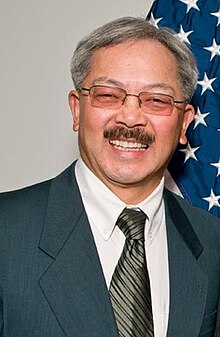Mayor of San Francisco
| Mayor of the City and County of San Francisco |
|
|---|---|

|
|
| Term length | Four years, renewable once |
| Inaugural holder | John W. Geary |
| Formation | 1850 |
| Website | Office of the Mayor |
The Mayor of the City and County of San Francisco is the head of the executive branch of the San Francisco city and county government. The mayor has the duty to enforce city laws, and the power to either approve or veto bills passed by the San Francisco Board of Supervisors, the legislative branch. The mayor serves a four-year term and is limited to two successive terms. Because of San Francisco's status as a consolidated city-county, the mayor also serves as the head of government of the county; both entities have been governed together by a combined set of governing bodies since 1856.
There have been 42 individuals sworn into office. John W. Geary, elected in 1850, was the first mayor of the city. Charles James Brenham, who served as mayor during the 1850s, is the only person who has served two non-consecutive terms. The previous mayor, Gavin Newsom resigned to become the Lieutenant Governor of California on January 10, 2011. Ed Lee was appointed by the Board of Supervisors on the following day to finish out Newsom's term. Lee was elected to his own term on November 8, 2011.
The mayor of San Francisco is elected every four years; elections take place one year before United States presidential elections on election day in November. Candidates must live and be registered to vote in San Francisco at the time of the election. The mayor is usually sworn in on the January 8 following the election. The next election for the mayor will be in 2019.
Under the California constitution, all city elections in the state are conducted on a non-partisan basis. As a result, candidates' party affiliations are not listed on the ballot, and multiple candidates from a single party can run in the election since a primary election is not held.
Mayoral elections were originally run under a two-round system. If no candidate received a simple majority of votes in the general election, the two candidates who received the most votes competed in a second runoff election held several weeks later. In 2002, the election system for city officials was overhauled as a result of a citywide referendum. The new system, known as instant-runoff voting, allows voters to select and rank three candidates based on their preferences. If no one wins more than half of the first-choice votes, the candidate with the fewest votes is eliminated and second-choice votes (and third-choice votes, if necessary) are counted until a candidate captures the majority. This eliminates the need to hold a separate runoff election and saves money. This was first implemented in the 2004 Board of Supervisors election after two years of preparation. In 2007, the new system was implemented in the mayoral election for the first time.
...
Wikipedia

